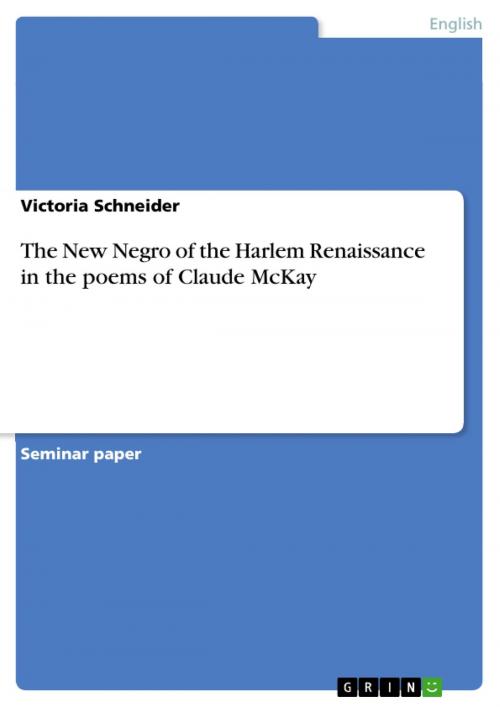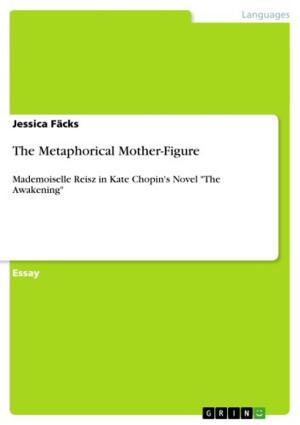The New Negro of the Harlem Renaissance in the poems of Claude McKay
Fiction & Literature, Literary Theory & Criticism, British| Author: | Victoria Schneider | ISBN: | 9783640943692 |
| Publisher: | GRIN Verlag | Publication: | June 24, 2011 |
| Imprint: | GRIN Verlag | Language: | English |
| Author: | Victoria Schneider |
| ISBN: | 9783640943692 |
| Publisher: | GRIN Verlag |
| Publication: | June 24, 2011 |
| Imprint: | GRIN Verlag |
| Language: | English |
Seminar paper from the year 2011 in the subject English Language and Literature Studies - Literature, grade: 2,3, University of Potsdam, course: African American Literature, language: English, abstract: Introduction At the beginning of the 20th century, the black population had to assess that they became the plaything of history and they did not have a bearing on their position in society. First of all, the African-Americans had to change their self-conception and their self-perception to achieve a special position in society as an individual. In these years, the black intellectuals were profoundly convinced that the new awareness of the Negro would mark a Renaissance in the history of the African-Americans. The discovery respectively the awareness about personal values, the newfound self-confidence on the one hand and the search for respect and appreciativeness on the other hand formed the base to create a new identity of the black population. Associated processes in politics, arts and especially in literature mobilized the creative strengths of many artists who lived primarily in Harlem at that time. At the beginning of this work, I want to look at theories about the term of the New Negro written by Booker T. Washington, W.E.B. Du Bois and Alain Locke. After that I want to illustrate the changed awareness and the soul of the New Negro with the help of selected poems written by Claude McKay. By doing so I want to show and highlight different aspects that the New Negro of the Harlem Renaissance embodied. The poems of Claude McKay, which were published in 1917, already dealt with the topic of the New Negro and therefore Claude McKay was believed to be a forerunner and the new voice of the Negro literature before the Harlem Renaissance had begun. The new self-image of the African-Americans, which was based on the pride of the own race, was not protected against the permanent discriminations initiated by the white population in America. None other could embody and process the ambivalence between the ideal and the reality in the United States as good as Claude McKay.
Seminar paper from the year 2011 in the subject English Language and Literature Studies - Literature, grade: 2,3, University of Potsdam, course: African American Literature, language: English, abstract: Introduction At the beginning of the 20th century, the black population had to assess that they became the plaything of history and they did not have a bearing on their position in society. First of all, the African-Americans had to change their self-conception and their self-perception to achieve a special position in society as an individual. In these years, the black intellectuals were profoundly convinced that the new awareness of the Negro would mark a Renaissance in the history of the African-Americans. The discovery respectively the awareness about personal values, the newfound self-confidence on the one hand and the search for respect and appreciativeness on the other hand formed the base to create a new identity of the black population. Associated processes in politics, arts and especially in literature mobilized the creative strengths of many artists who lived primarily in Harlem at that time. At the beginning of this work, I want to look at theories about the term of the New Negro written by Booker T. Washington, W.E.B. Du Bois and Alain Locke. After that I want to illustrate the changed awareness and the soul of the New Negro with the help of selected poems written by Claude McKay. By doing so I want to show and highlight different aspects that the New Negro of the Harlem Renaissance embodied. The poems of Claude McKay, which were published in 1917, already dealt with the topic of the New Negro and therefore Claude McKay was believed to be a forerunner and the new voice of the Negro literature before the Harlem Renaissance had begun. The new self-image of the African-Americans, which was based on the pride of the own race, was not protected against the permanent discriminations initiated by the white population in America. None other could embody and process the ambivalence between the ideal and the reality in the United States as good as Claude McKay.















